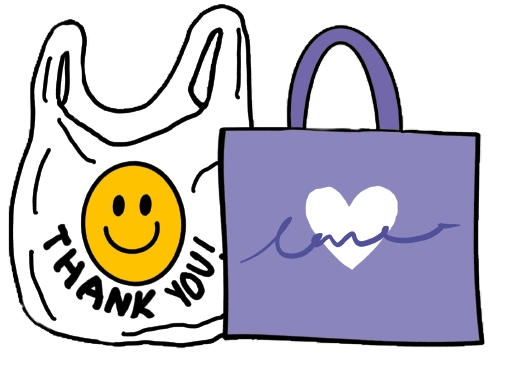Who’s the actual villain: the truth about plastic bags and climate change

Over 70 percent of fish in the sea have plastic in them, but the alternatives may be worse.
September 14, 2020
We can all agree: plastic is bad for the environment. But did you realize that the plastic bag could actually be better than your alternative option?
I would not have believed this statement myself. The plastic so often demeaned by eco-activists for killing animals and causing endless pollution—that plastic is better than the alternatives, such as cotton, polypropylene and paper bags, created to ameliorate this situation?
First, let’s take a step back. The 8 million metric tons of plastic currently floating in the oceans and killing 1 million sea animals is not exactly plastic’s fault. It’s our fault—even when we believe to be doing good when recycling. Recycling is such a labor-intensive job that it is often shipped to countries such as Malaysia, Indonesia, Thailand and Vietnam with high rates of “mismanaged waste,” where they dump the recycled plastic into the ocean.
But still, with all of those setbacks, how could the glorified cotton bag score worse than plastic bags, who already set the bar pretty low? I mean, an astounding amount of energy is used to produce these plastic bags. The amount of energy needed to drive a car for one kilometer is equivalent to the amount of energy required to make nine plastic bags. Bear in mind, one to five trillion plastic bags are used per year worldwide.
Due to these undeniable flaws, consumers have been introduced to multiple alternatives to single-use plastic bags. After all, there are plenty of fish in the sea—though over 70 percent of the fish have plastic in them.
These alternatives include cotton, polypropylene and paper bags, just to name a few. As mentioned above, plastic bags take a lot of energy to produce. But what is not as well known is that the alternative bags actually take more energy than plastic ones when in the manufacturing process. It may surprise you that cotton bags, which are so touted by environmentalists as a healthier alternative, have to be used 50-150 times to equal the carbon footprint of a single-use plastic bag. For polypropylene bags, the figure is 10-20 times and for paper bags, 4-8 times.
Basically, if you purchase a cotton bag and only use it a dozen times, you are actually causing more harm than if you were to use a plastic one. Moreover, in areas where governments have banned single-use plastic bags, customers buy thicker substitutes with a larger carbon footprint, thus worsening the issue.
Perhaps we should not immediately vilify plastic bags or praise the alternatives. In reality, they rank best in almost every environmental category in terms of the carbon footprint. In other words, the production of plastic bags releases less carbon dioxide into the atmosphere than those of the alternative ones. The light weight of these bags means they take up minimal space in landfills, unlike blockier bags.
The solution comes down to awareness and spreading it. We need to recognize that not all of the material we carefully recycle ends up in the format we were promised by following code green and all. Next, we need to know the amount of times a certain alternative bag needs to be used until it equates to the carbon footprint of single-use bags. Purchasing a polypropylene bag then only using it twice is not enough.
So what do you do now? Stop all recycling and go on a single-use plastic bag spree?
No.
Keep recycling and responsibly disposing of your bags and be more conscious of associating yourself with companies that promise to finish what you started recycling.
As for what type of bag to use now, we are already too far into the reusable bag conversion to go back. So whatever you own, whether it be a cotton bag or a single-use plastic one, just use it a lot.











Joe Miller • Jan 7, 2021 at 12:43 am
Spam comment detected.
Ann Burdick • Oct 14, 2020 at 5:19 pm
Interesting points brought out on an important topic. THANKS!